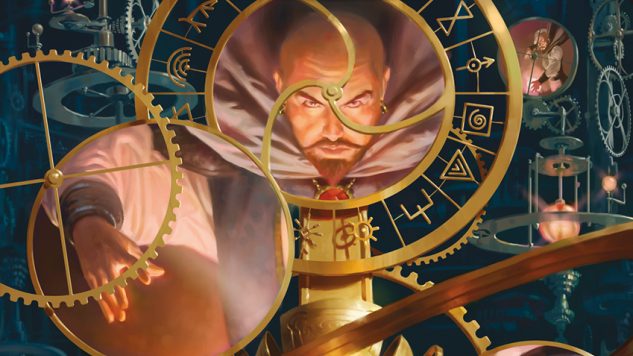The fiction of Dungeons & Dragons encompasses a lot of things. There’s the Material Plane, where normal everyday stuff happens. There are planes where gods live, and there are planes in which the encapsulations of fire, water, earth and wind just hang out kicking ass all day long. There’s the Abyss and the Nine Hells, the realms of demons and devils respectively (in D&D those are very different kinds of creatures). Mordenkainen’s Tome of Foes, the newest book out of the D&D team that released in game stores May 18 and everywhere else on the 29th, doesn’t necessarily bill itself as being focused on the affairs of those extra-planar gods and devils, and yet the content is almost wholly devoted to them. How much you enjoy and use the book is going to depend on how important gods and devils are to your D&D experience.
On one hand, I don’t think that Mordenkainen’s Tome of Foes is a bad sourcebook for D&D. It has lots of great information about the different playable species of the game, their pantheons of good and evil gods, and solid explanations for how those gods impact the long and short term lives of those species. If you were, for example, making a game about the destruction of the Elven pantheon by vengeful Orcish gods, this book has all the info you would need to really ground that and make it pop for your players.
Even better, it has explanations of all the major devils and demons of the D&D universe so that you can really sell a story about those entities to players. Asmodeus, the lead devil of the cosmology, is delightfully Satanic, and even reading through the book I was trying to figure out how to fit him into the campaign that I am currently running without disrupting the flow and feeling of the world that I am working in.
And that, for me, is the other hand: Mordenkainen’s Tome of Foes feels like a book you need to build your campaign around. The two previous sourcebooks of its type, Xanathar’s Guide To Everything and Volo’s Guide To Monsters, are both books that I use constantly as a Dungeon Master. The former is a rules expansion and clarification that helps to build out the interactions of any campaign, and the latter is a book of monsters that any party could come upon during any given romp through the world. They are books that are grounded in the dusty roads and dirty swords of fantasy tabletop campaigns, and they slot easily into the workflow that I have to make those kinds of adventures feel good.
Mordenkainen’s Tome of Foes doesn’t work that way. It starts at a very high level of the D&D cosmology, and it feels harder to borrow from or augment than other D&D source books. For example, my campaign setting is a home-rolled fiction partially created by myself and my players. The core assumptions of Dungeons & Dragons make their way into my campaign, but I’m not using the stock Dwarven gods with all of their lore and connections. Similarly, I’m not using D&D devils and demons, their Blood War, or even their idea of the afterlife.
If you’re interested in that canonical approach, then this book has you covered. It has deep descriptions of all of these cosmic beings, and there are statistical blocks in case you want to fight them. If you’re curious about how these beings impact the daily lives of mortals, there’s lots of info about that as well. But there’s very little of this book that I can use in my campaign because it’s all so dependent on each other. The cosmic balance of D&D is so well thought-out and specific that it’s hard to lift one piece out to use by itself.
If I wanted to use Asmodeus, that big ole Satan I talked about before, I would have to do an operation like this. First, I might have a plot point about making a deal with a devil. Devils are bound by contracts, so my players could make a very explicit deal and either fulfill it or try to escape it. If it’s Asmodeus, I might need to explain that he’s the lord of all of the devils. Then I have to figure out why he’d make this deal. In canonical lore, it’s because he’s into collecting souls because the Nine Hells, the place he lives, has a complicated economy of soul intake and soldier output that needs to be supported at all times. If I wanted to pluck him out of that and make him, say, a soul collection enthusiast, then what’s the point of using Asmodeus? Why not just a powerful magic user of a lich? The parts of cosmology on display in the book are all so cohesive that it doesn’t make much sense to me to go piecemeal. None of it slots into anything else very well.
The struggles of the githzerai and the githyanki, two rival species politically separated for eons, are included in this book, as are interesting facts about psychic dwarves called duergar, different factions of elves, and Garl Glittergold, god of the gnomes. And, much like Volo’s Guide, there are ample statistical blocks to help you pit all of these creatures, gods and devils up against your players. But my fantasy campaign isn’t going to be running into any of these extra planar creatures on a shoddy cart path anytime soon, and it’s hard to imagine that any grounded campaign would ever really have need of these creatures.
If your campaign is going to the planes, talking to gods, and fighting with demons, then you definitely need Mordenkainen’s Tome of Foes. If that’s not happening, then maybe it isn’t for you.
Cameron Kunzelman tweets at @ckunzelman and writes about games at thiscageisworms.com. His latest game, Epanalepsis, is available on Steam.